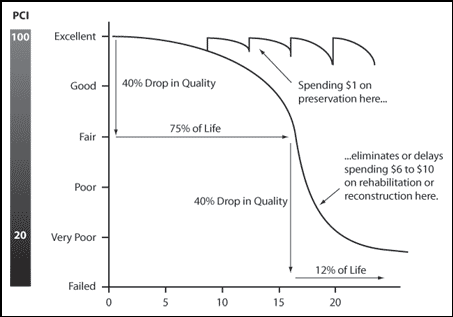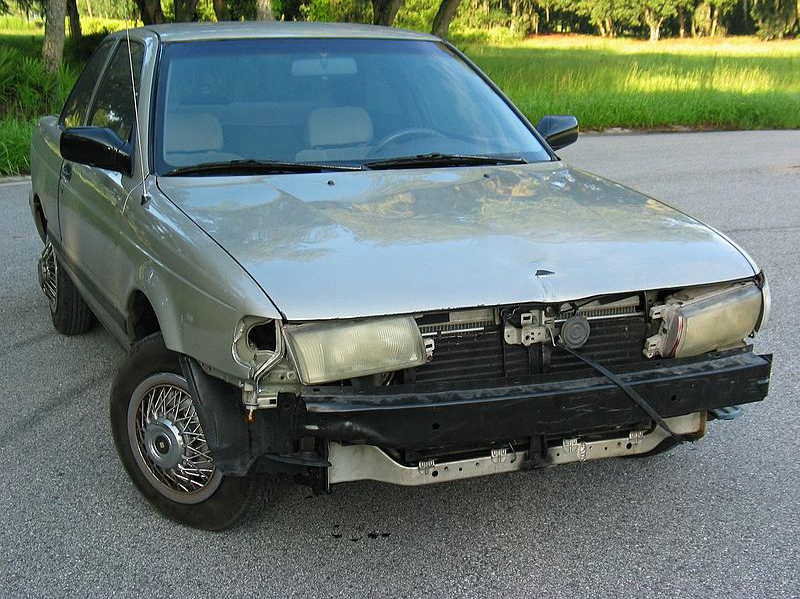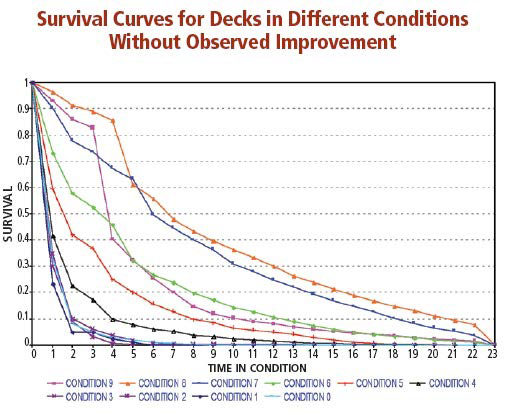4.1: Introduction
- Page ID
- 21124
As soon as infrastructure is newly built or rehabilitated, it begins to deteriorate. The decline in overall infrastructure condition may be slow, but it is inevitable. The decline may be mitigated by preventive maintenance or even reversed by major rehabilitation actions such as repaving, but deterioration will again proceed without continuing interventions that are likely to be expensive.
The common ‘Deterioration Hypothesis’ posits that infrastructure will deteriorate over time due to use and other factors. The strict form of the ‘Deterioration Hypothesis’ assumes that conditions cannot improve over time unless there is an intervention by infrastructure managers and workers. Typical factors causing deterioration are weathering, corrosion, use-related stress, and general wear-and-tear. Figure 4.1.1 illustrates the deterioration hypothesis with slow condition degradation for a period of time, then a more rapid deterioration as the infrastructure ages and its condition degrades. As shown in the figure, interventions for asset preservation can improve the asset condition rating, but the deterioration then resumes.

Figure \(\PageIndex{1}\): Illustration of the Deterioration Hypothesis. Source: Federal Highway Administration, Publoc Domain, ‘Asset Sustainability Index, http://www.fhwa.dot.gov/planning/pro...dex/page01.cfm. A decline in condition over time without preservation efforts.
While the deterioration hypothesis is used for infrastructure components, it is also relevant and used for a variety of other devices. For example, paper may deteriorate due to insects, mold, fire, water damage, chemical reactions caused by light, wear-and-tear in use and other factors. Mechanical equipment is similar expected to deteriorate over time. For example, Figure 4.1.2 shows a worn car. In many cases, worn equipment must be replaced by regulatory requirements or owner decisions.

Figure \(\PageIndex{2}\): Example of Vehicle Deterioration Over Time and Use. Source: By FlyByFire (Own work) [CC BY-SA 3.0 (http://creativecommons.org/licenses/by-sa/3.0)], via Wikimedia Commons, https://commons.wikimedia.org/wiki/F...ter_Nissan.jpg
The choice of materials and quality of construction can slow the process of infrastructure deterioration. Similarly, favorable weather conditions can make even inevitable deterioration quite slow. For example, water penetration with freeze-thaw cycles in colder climates can result in more rapid occurrence of pavement cracking. Figure 4.1.3 shows the probability of acceptable quality (shown as ‘survival probability’) for bridge decks without rehabilitation work with different material, traffic and environmental conditions. As can be seen, the spread of survival probabilities over the different conditions is quite large.

Figure \(\PageIndex{3}\): Probability of Survival (Acceptable Condition) for Bridge Decks. Source: FHWA, ‘History Lessons from the National Bridge Inventory, Public Domain, http://www.fhwa.dot.gov/publications...s/08may/05.cfm. Illustrates different conditions of materials, traffic and weather.
As the condition of infrastructure declines, infrastructure managers must consider what steps (if any) should be taken to reverse the deterioration. Some decisions are relatively simple, such as intervening on structures in danger of collapse. More commonly, infrastructure managers make such decisions as part of the asset management process described earlier.
An important input into such decision making is the expectation of deterioration in the future if nothing is done to reverse the existing damage. Deterioration modeling is a process of taking condition assessment information (as described in Chapter 3) and forecasting expected future conditions.
Numerous approaches to deterioration modeling exist. In this chapter, we will briefly discuss the following approaches:
- No deterioration modeling. Use existing conditions for decision making.
- Extrapolation/Moving Average of conditions over time.
- Regression Models based on statistical analysis.
- Markov Models of probabilistic deterioration.
- Semi-Markov Models of probabilistic deterioration
- Neural Networks using an artificial intelligence approach based on a learning set of deterioration examples.
- Failure Distributions and Fault Tree Analysis to assess the probability of failure.
In this discussion, our intent is to provide sufficient background for infrastructure managers to understand the different approaches, including their advantages and disadvantages. Where appropriate, references are provided for those wishing to delve more completely or deeper into particular approaches.
Finally, all of the deterioration modelling approaches noted above depend upon empirical data on component deterioration. Keeping such records is a critical asset management task!


